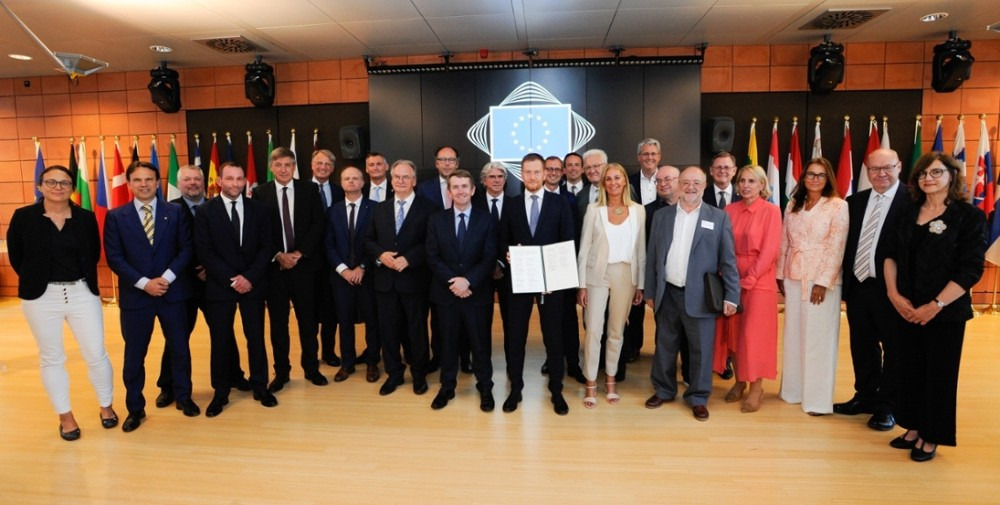ESRA sees itself as a platform of the regions and partner of the European Commission in the implementation of the European Chip Act. It wants to make an active contribution to strengthening Europe as a semiconductor location in global competition and to promote the competitiveness of the semiconductor industry in the regions of the European member states as well as in the entire European Union.
To this end, ESRA relies on the exchange of knowledge, the promotion of cooperation and innovation, the development of strong, integrated and resilient value chains as well as the reduction of one-sided dependencies, especially in critical raw materials. Growing European semiconductor manufacturing is expected to secure industrial production in the EU as a whole and make it more competitive with the U.S. and China.
Michael Kretschmer, Minister President of the Free State of Saxony, emphasized, “The establishment of the Microelectronics Alliance at the initiative of Saxony is an important milestone for the entire European Union and its future. For each segment of the global semiconductor value chain, it takes an average of more than 20 countries involved in the direct supply chain and working closely together. With ESRA, we are opening up new ways for regions to collaborate, research and innovate, ensuring Europe’s economic and digital sovereignty. The participation of many regions in the launch event underlines the interest in increased cooperation at EU level in the field of microelectronics. The Alliance will make an important contribution to making Europe competitive in this key industry in the years to come.”
Michael Murphy, CoR Vice-President and Tipperary County Council member: “The semiconductor industry has a rich talent pool, a comprehensive ecosystem with strong research links across the value chain, from design, architecture and manufacturing to systems and applications. Semiconductor manufacturers have the power to, and do, transform local economies both directly and indirectly. It is essential that national governments recognize the economic potential of the semiconductor industry in all regions of Europe and provide the necessary support for the development of a strong and integrated value chain.”
The Saxon Regional Development Minister Thomas Schmidt, member of the European Committee of the Regions (CoR) and rapporteur there on the European Chips Act (ECA): “Following the adoption of the European Chips Act, it is now a matter of implementation, of locating new production facilities, strengthening research and training skilled workers. The ‘European Semiconductor Regions Alliance’ sees itself as a partner of the European Commission. As rapporteur of the European Committee of the Regions, I intensively accompanied the European Chips Act. It is good that Saxony, as one of the largest semiconductor locations in Europe, has taken the initiative. I support the ten points for founding the alliance with full conviction. The fact that the founding event can take place in the Committee of the Regions shows how important the regions are for Europe and the semiconductor industry.”
Jan Jambon, Prime Minister of Flanders: “Today’s founding of ESRA is an excellent example of pan-European cooperation between like-minded regions from across the continent. European research policy shines through bottom-up innovation. For the Flemish government, research and development are of utmost importance and value. One in five foreign investments in Flanders is related to R&D, and the Flemish government invests 3.6% of its GDP in innovation, ranking top in Europe. However, it is also important to complement innovation with a new model of collaboration between knowledge institutions, industrial players and regional decision-makers.”
In the jointly signed 10-point paper establishing the European Semiconductor Regions Alliance, the regions hold the following objectives:
- ensure the best possible and innovative support and competitive framework conditions for the regions within the framework of the European Chip Act, as well as a long-term definition of funds in the EU’s Multiannual Financial Framework to increase European semiconductor production;
- achieve the greatest possible flexibility and speed in the examination and granting of state aid in the semiconductor industry;
- Expand research and development and promote networking of research institutions in and between the various regions and develop unique technological features;
- Develop and implement solution approaches for a more sustainable production of semiconductors in the context of the European Green Deal;
- ensure sufficient water and energy supply at the production sites as well as supply with all necessary, especially strategic and critical raw materials;
- strengthen cooperation in the field of talent development as well as education and training of skilled workers, in the recruitment of non-European skilled workers as well as international university cooperation;
- Cultivate and intensify cooperation of existing clusters;
- Conduct events in cooperation with industry players;
- articulate and represent common interests of member regions vis-à-vis the EU Commission and EU institutions, as well as
- Networking and coordination of the regions involved at the working level and networking with industry associations and other European networks.
The alliance includes 27 regions from 12 EU member states. ESRA networks the following regions: Baden-Württemberg, Bavaria, Hamburg, Hesse, Lower Saxony, Saxony, Saxony-Anhalt, Saarland, Schleswig-Holstein and Thuringia in Germany, Andalusia, the Basque Country, Valencia and Catalonia in Spain, Flevoland and North Brabant in the Netherlands, Carinthia and Styria in Austria, the Centro region in Portugal, Flanders in Belgium, Auvergne-Rhône-Alpes in France, Piedmont in Italy, Tampere and Helsinki in Finland, South Moravia in the Czech Republic, Wales in the United Kingdom and the Republic of Ireland.
Background on the creation of the initiative
Already in March 2023, the Free State of Saxony initiated the process to establish the “European Semiconductor Regions Alliance” (ESRA). 13 regions from nine EU member states had expressed their will to cooperate in a joint declaration of intent.
Against the backdrop of Europe’s insufficient semiconductor resilience, high supply chain sensitivity and high dependence on semiconductor imports, the European Commission proposed a comprehensive package of measures to strengthen the EU’s semiconductor ecosystem – the European Chips Act (ECA) – on February 8, 2022. The Commission’s goal is to increase Europe’s market share in global chip manufacturing from the current level of just 10% to as much as 20% by 2030. To achieve this, the Commission wants to mobilize public and private investment of up to €43 billion.
The ECA was adopted with strong support from the EU institutions. The European Committee of the Regions accompanied the process and pointed out the importance of the ECA for securing Europe as an industrial location. The European Parliament overwhelmingly approved the ECA on July 11, 2023. Similarly, the Council of Ministers approved the project on July 25, 2023. The act is intended to promote the production of microchips in the EU and thus reduce dependence on other markets such as Asia or the United States.
– – – – –
Further links
👉 10-point paper
👉 European Chips Act
👉 Strong together: Europe’s semiconductor regions united in global competition
Image: Philippe Veldeman



